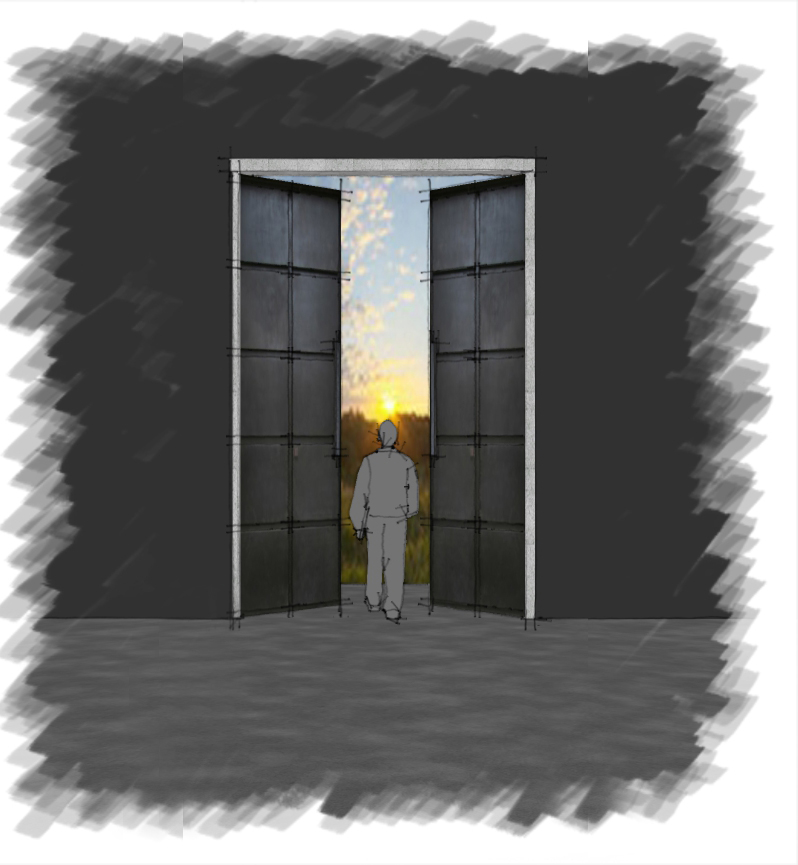
by Jeff Serbin | Jul 28, 2018 | ADA, architect in Arizona, Architecture, Blog, building code, Uncategorized
Door size – Building Codes – Size Matters
As an Architect, I interact with clients, engineers and contractors who have acquired bits of information about Building Codes. Sometimes, those bits are misconceptions and regurgitated information. The building codes can be intimidating and have no beginning or end. To learn the code, the best way is jumping in feet first. Door size matters.
Upcoming Blog Posts
In the next series of blog posts, I will explore common simple and more complex Building Codes. Each City has adopted a code but most in Arizona use the IBC (International Building Code).
The issues to be addressed in the following Blog Posts are:
- Door swing direction. Which way should the door swing, out of a room or in?
- Number of exits within a room?
- Door Size. Who said “size doesn’t matter.”
- Exit corridor width. How wide or narrow can a hallway be?
- Clearances around a door? Door arrangement between two doors.
- Door fire ratings. Is your door fire rated?
- Exit Travel Distance.
- Do I need an Elevator?
- Should my door have panic hardware?
- Do I need a drinking Fountain?
- Minimum size of a single person toilet room?
- Small commercial space, is one bathroom enough?
The item in bold to be addressed in this post. As an Arizona Architect, most City’s jurisdictions work with the IBC (International Building Code). The code analysis is based upon the IBC.
Door Size

Does size matter! That’s huge.
Doors are a means of egress within a building. The size of door is to allow for safe passage of occupants within the building and to allow for exit in case of emergency. The size allows for egress of able body and occupants using wheelchairs. Door Size is determined by minimum size requirements and occupancy loads. As you explore the code, you see a trend that occupancy load effects many elements of the building.
The code indicates that a door provide a minimum of 32″ clear when open 90 Degrees. If you look at the specific detail below, depending on door thickness, the door hinges used and the clearances you take into account around the door itself, a door itself has to be minimum ~2′-11″ wide. For ease of construction, doors are typically 3′-0″ or 36″ wide to take into account variables in the components. There are however a few exceptions to the code. Those pertain mainly to residential projects, storage closets and revolving doors. Projections into the clear width such as door handles, stops, closers, etc. are allowed at 34″ above finish floor as long as they don’t exceed 4″ into the clear space.
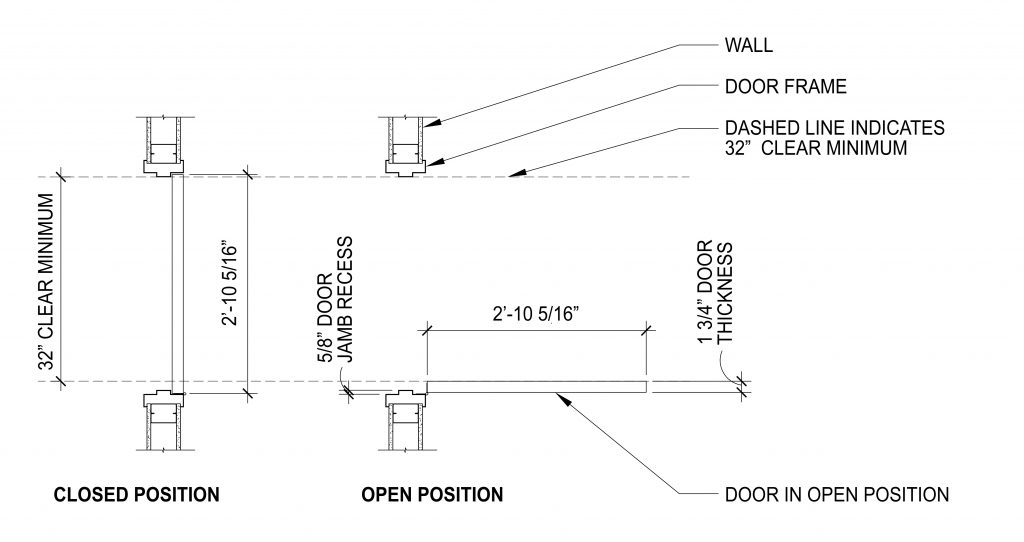
Door size minimum in commercial building
If size matters, who said it’s too big? Per IBC (International Building code), maximum width of a swinging door leaf shall be 48″.
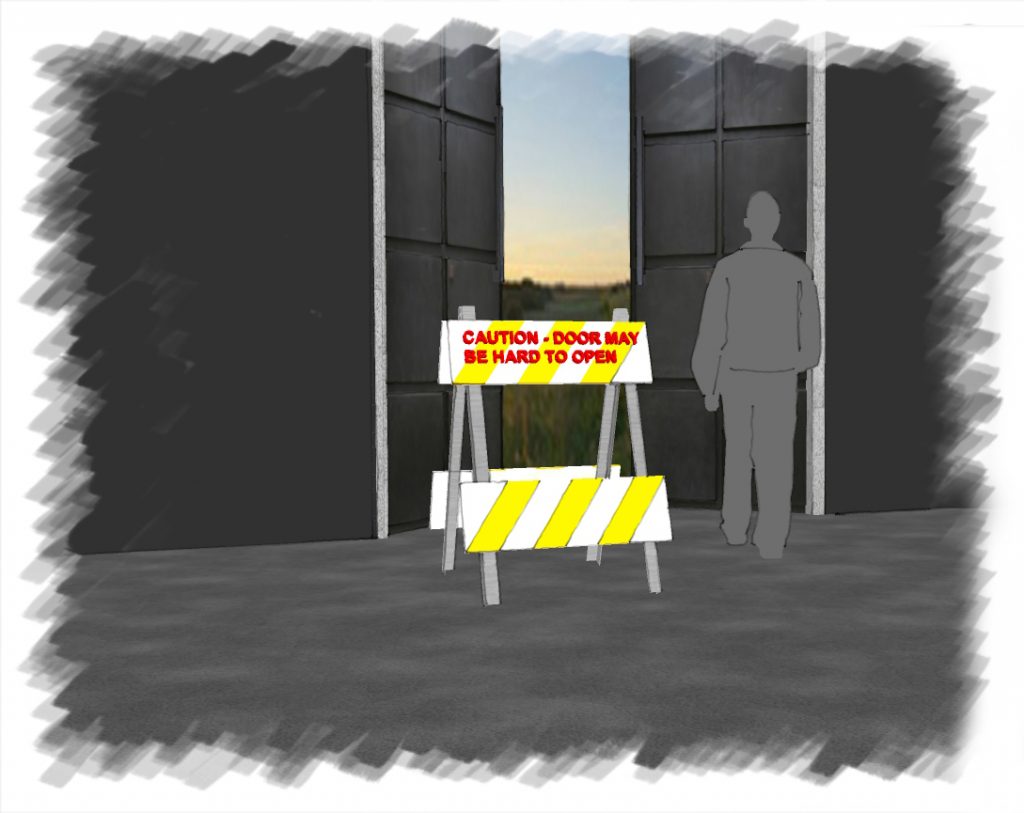
Who said it’s too big!
Door height minimum is 80″ or 6′-8″. I have yet to find in the code a maximum height of a door. A governing factor may be how easy / difficult it is to open the door itself. There are requirements in the code for the maximum force required to open a door. So I suppose, a door too big would exceed those. If you find a section, let me know.
Means of Egress
Another factor to door width relates to occupancy quantities. Means of Egress – “The continuous and unobstructed path of egress travel from occupied space to a public way”. The minimum size of the door or doors can also be affected by this requirement. For example, if an occupant load exceeds 160, the door width of 36″ will not suffice as shown in equation below.
Per IBC 1005.1, means of egress width is determined by the number of occupants x 0.2 inches.
160 occupants x 0.2 inches = 32 inches.
Therefore if the occupant load through a door is greater than 160 occupants, a single 36″ wide door would not suffice. Possibly a 48″ wide door would work, but in most scenarious, (2) 36″ doors or multiple exits doorways would handle this scenario. Note: stairwells have a multiplier of 0.3 inches.
Additional Requirements
Within Assembly occupancies, means of egress and exits have different requirements as shown in IBC section 1028. If your interested in further analysis, I will cover that in another blog post.
Summary
Door size does matter. The code clearly indicates the minimum and maximum size of doors. Occupancy quantities has some affect but as depicted, on larger scale projects. On many projects, a typical 36″ door will suffice in an exit condition unless you exceed specific thresholds.
When learning building codes, once you begin digging into the code, it begins to make sense. However when in doubt, rely on an Architect to explore the code and assist you.
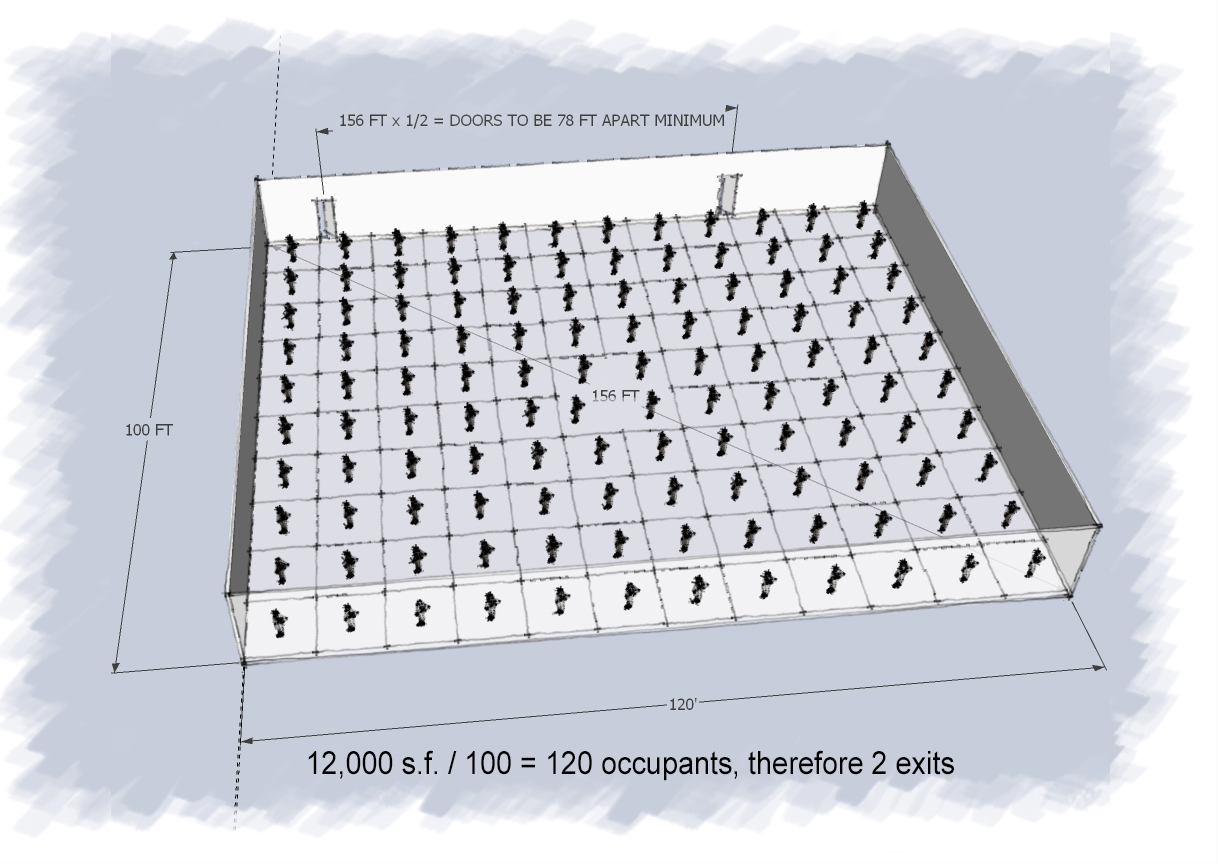
by Jeff Serbin | Jul 23, 2018 | ADA, architect in Arizona, Architecture, Blog, building code, Uncategorized
Number of Exits Within a Room – Building Codes
As an Architect, I interact with clients, engineers and contractors who have acquired bits of information about Building Codes. Sometimes, those bits are misconceptions and regurgitated information. The building codes can be intimidating and have no beginning or end. To learn the code, the best way is jumping in feet first.
Upcoming Blog Posts
In the next series of blog posts, I will explore common simple and more complex Building Codes. Each City has adopted a code but most in Arizona use the IBC (International Building Code).
The issues addressed in the following Blog Posts are:
- Door swing direction. Which way should the door swing, out of a room or in?
- Number of exits within a room?
- Size of the door. Who said “size doesn’t matter.”
- Exit corridor width. How wide or narrow can a hallway be?
- Clearances around a door? Door arrangement between two doors.
- Door fire ratings. Is your door fire rated?
- Exit Travel Distance.
- Do I need an Elevator?
- Should my door have panic hardware?
- Do I need a drinking Fountain?
- Minimum size of a single person toilet room?
- Small commercial space, is one bathroom enough?
Item in bold is addressed in this post. As an Arizona Architect, most City’s jurisdictions work with the IBC (International Building Code). The code analysis is based upon the IBC.
Number of Exits within a Room
The number of exits within a room is determined by the occupancy and the level of hazardous condition. The type of Occupancy (ie. office, retail, industrial etc.) generally determine quantity of occupants based upon a load calculation. For example:
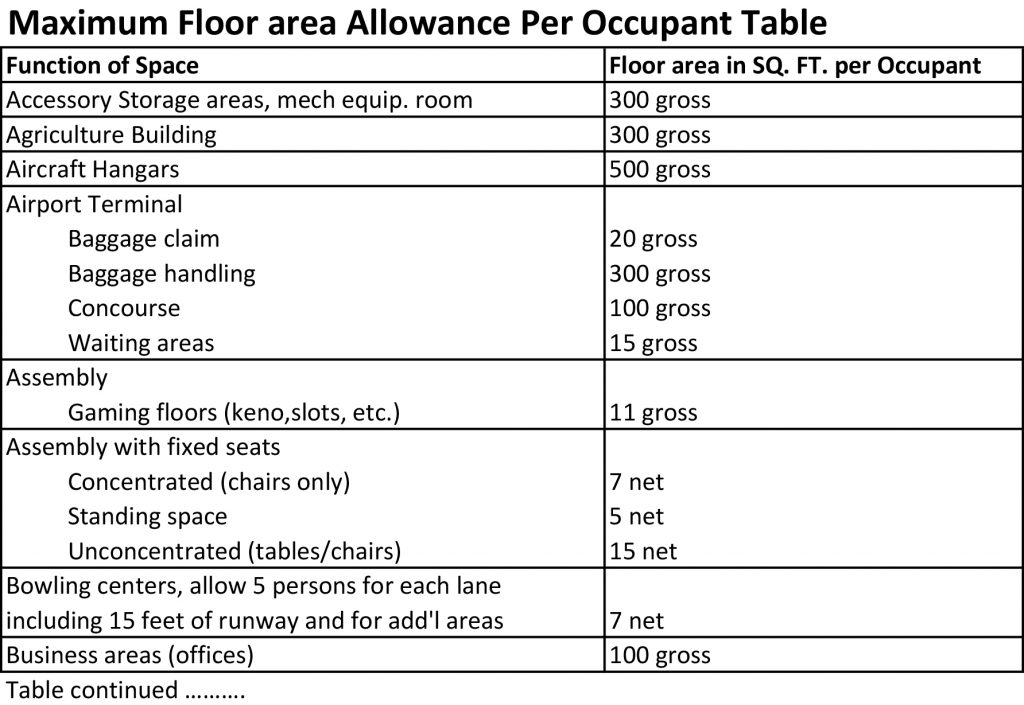
Portion of Occupancy Table
Once the number of occupants is determined, a maximum number of occupants are allowed before second or possibly third exit is required. The general rule of thumb are as follows:
Number of Exits Rule of thumb
In occupancy’s such as business group (offices), Assembly (Theaters, night clubs, restaurants), Educational (Schools), Factory (manufacturing), Mercantile (stores, markets, retail) and Utility (agriculture buildings, barns, sheds), if occupant load stays below 49 people, one exit is required. Other factors may play into the requirement, such as travel distance, but that will discussed in a later blog.
In hazardous occupancy’s, the maximum occupant load is greatly reduced to either 3 or 10, depending upon the use, before a second exit is required. In storage occupancy the number of occupants allowed before a second exit is required is 29.
Once occupant loads reach greater numbers, such as 501 – 1,000 occupants, minimum 3 exits are required. Beyond 1,000 occupants, four exits are required. An example of this may be a large conference room or convention center where spaces are large enough to hold these quantities.
Another requirement to take into account is location of the exits themselves. A good rule of thumb to follow is that the distance separating the exits must be greater than 1/2 the distance of the overall diagonal dimension of the room. So in a large office space that is an open plan with no walls, such as the one depicted below, the number of occupants possible by code would be 12,000 s.f. / 100 s.f. per person = 120 occupants. this exceeds 49 occupants therefore 2 exits required. See graphic below.
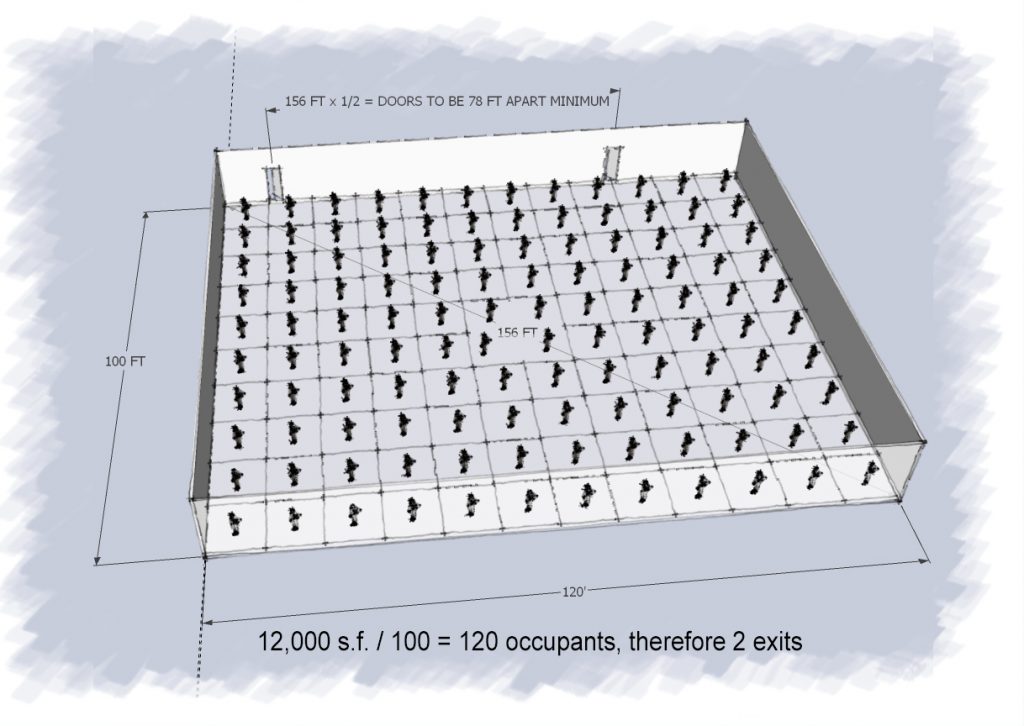
Exit calculation
Summary
Number of exits and their separation are dependent upon occupant loads. Once a threshold of occupants are met, exit quantities increase. Separations of those exits are required to allow for occupants to safely exit in time of emergency. For example, if a fire occurs within one side of the room, having adequate separation ensures that both exits are not blocked.
When learning building codes, once you begin digging into the code, it begins to make sense. However when in doubt, rely on an Architect to explore the code and assist you.
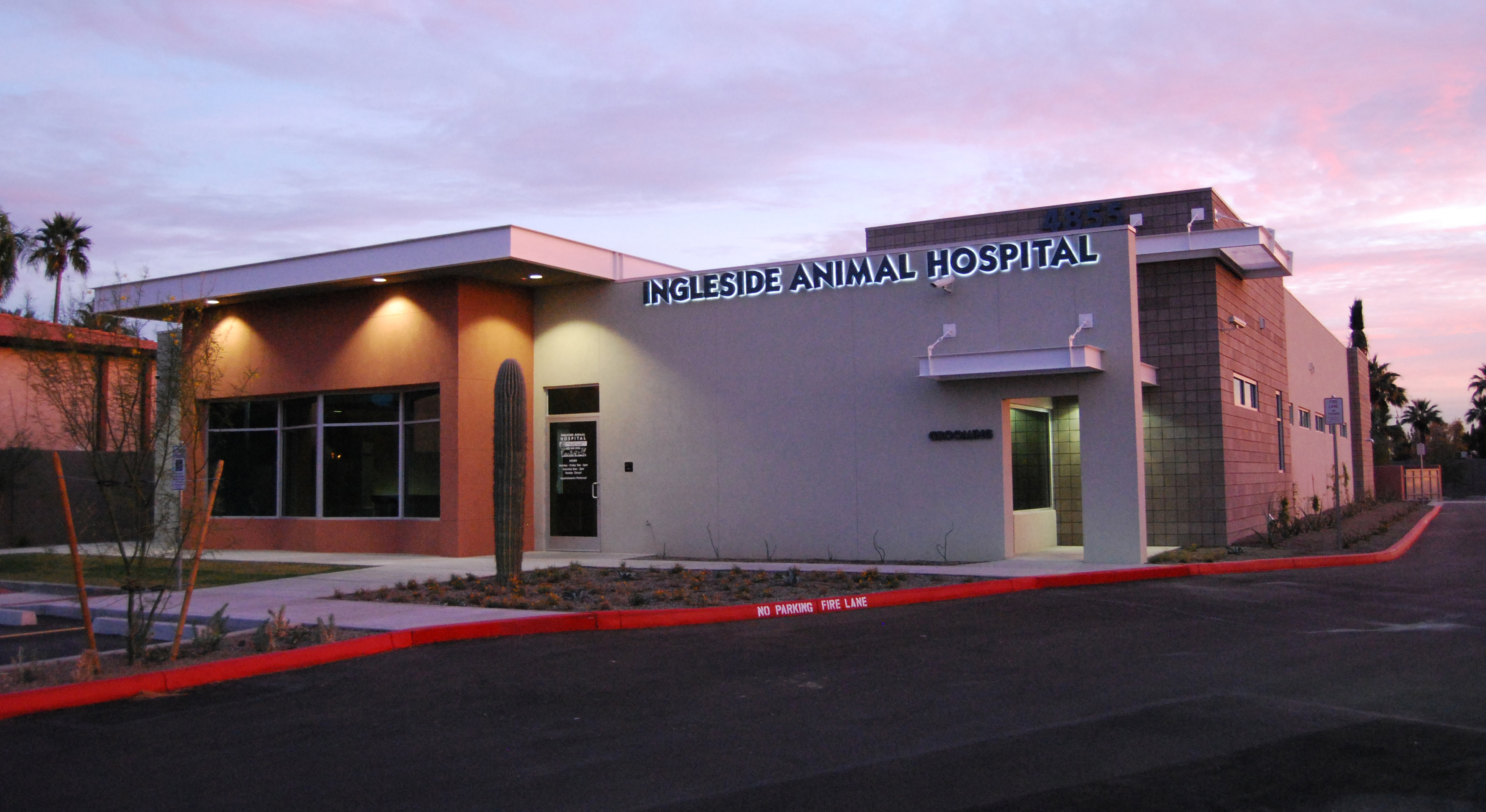
by Jeff Serbin | Jul 13, 2018 | Architectural Planning, Architecture, Blog, phoenix architects, Planning, Uncategorized
Animal Hospital Design in Arizona
Building a new Animal Hospital Design in Arizona, a Grooming Facility or boarding facility is a humbling and exciting endeavor. The most important part of the process is to put together a qualified team to tackle the project. The team may comprise of the following:
- Architect
- Accountant
- Banker
- Construction Manager
Where do you begin? First start with the dream and visualize what the facility may comprise of. If its a Hospital, how many exam rooms or surgical tables do you desire? Will the facility include grooming? Boarding animals overnight? Boarding cats, dogs or other types of animals? Will the building be for small or large animals? Many of these questions should be asked, but as part of the dreaming, a budget needs to be blended into the dreams so the project is practical.
Planning
The project will not be simply putting a drawing together, getting an estimate, financing and constructing the building. You will spend time working with the team to come up with the details, specifics for the layout of the building and the type of equipment you desire to function properly. Are you looking at an existing building and doing a tenant improvement or will you be creating a new building? The process can take months and possibly years to see completion, depending on the steps required to create your dream facility.
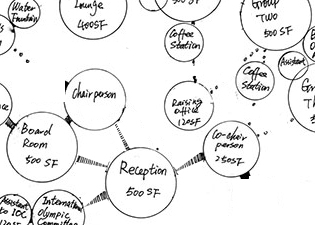
Programming Bubble Diagram
Hiring an architect with veterinary experience certainly makes the project easier. An architect can provide you with examples and guidelines that address many concerns from size of rooms, workroom flow within the facility, options in materials and code requirements. The architect can take a look at an existing building and create floor plan options to explore the best us of the space. When building a new building, floor plan options can explore the site for the best building approach, best solar orientation, best use of the parking for unloading of the pets and understanding the zoning requirements.
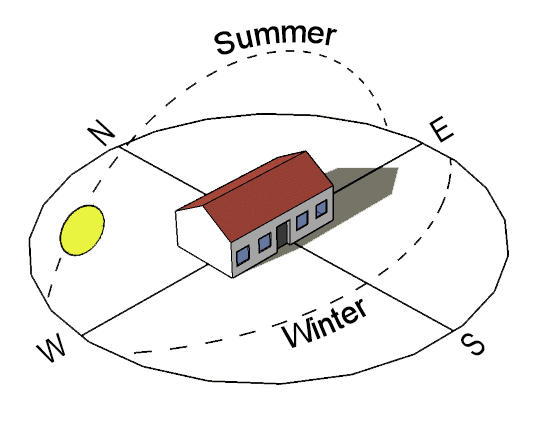
Solar orientation
When financing a project, going to the lender or bank with only a dream vision is typically not enough. The architect can take your dream and take the ideas in words and create the conceptual plans that allow a contractor to determine an estimated construction cost. The lender will typically need a conceptual drawing, estimated construction cost and your business plan. This information will give a good impression to the lendor, that you have a good plan for your new endeavour.
Construction
Once the design has been completed, the contractor has been selected, the building permits and other approvals are obtained and the financing has been established, the exciting part is watching the facility become a reality. All the time and effort finally begins to pay off. Your involvement is not finished as we strongly recommend your involvement during the construction. During the construction phase, there are many decisions that need to be made. The architect role should be overseeing the contractors construction to ensure they are using the correct finishes and equipment as specified in the drawings. Your involvement should include the finishing touches, such as final approval of finishes, selection of furnishings and final walk through to ensure the project completion.
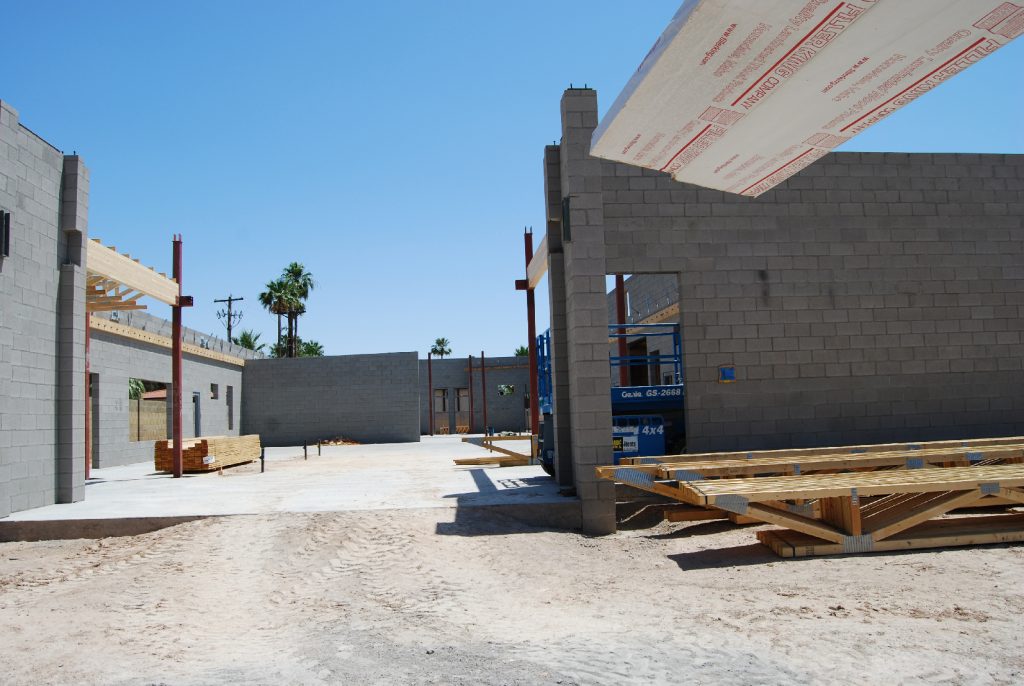
Construction Photo
Summary
When working on a Animal Hospital Design in Arizona, investing in an architect with veterinary building experience will ensure the facility has been built with a design that satisfies your needs, has a good workroom flow, is built of quality materials and falls within a reasonable project budget. Whether it is a tenant improvement or a new building, the process of creating a new Veterinary Facility (Animal Hospital), Grooming Facility or boarding facility can be a rewarding experience.
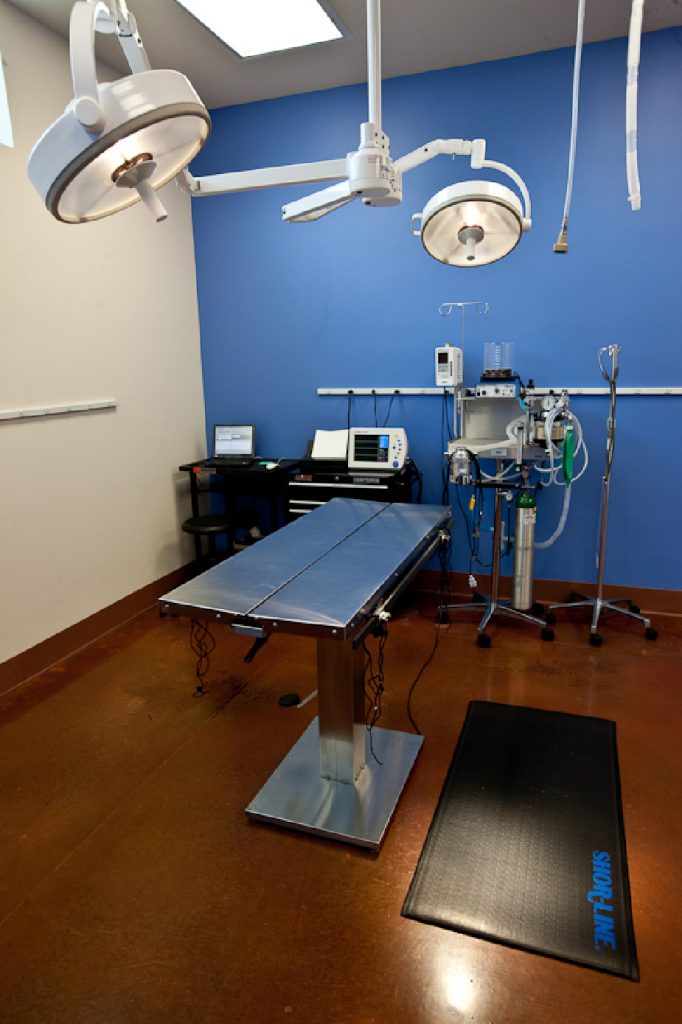
Animal Hospital Design
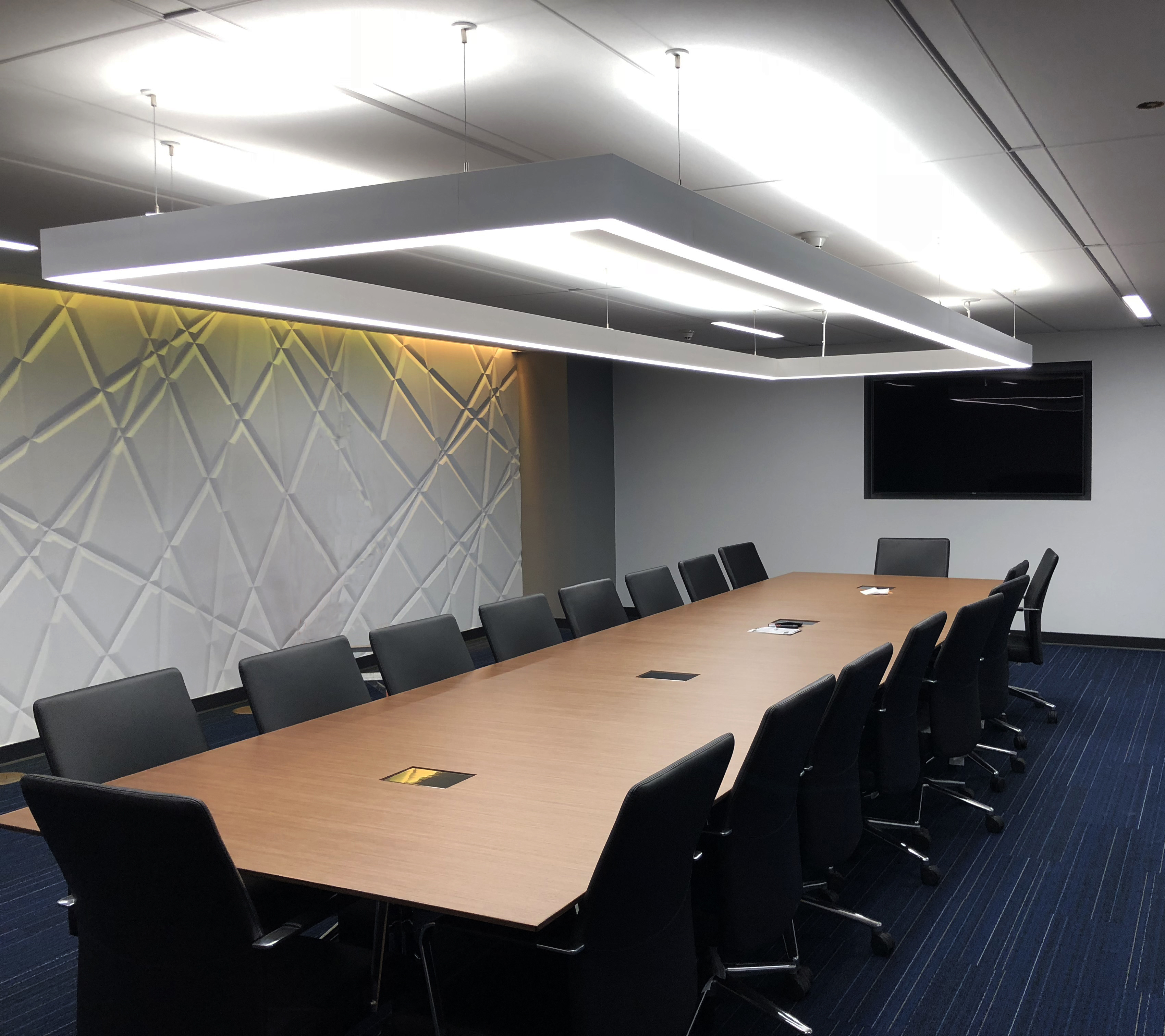
by Jeff Serbin | Jul 12, 2018 | architect in Arizona, Architecture, Blog, Interiors, office architecture, office design arizona, office improvement, phoenix architects, Planning, Uncategorized
Office Architecture in Arizona
When finding an office Architecture in Arizona for rent within existing real estate, some research should be completed before signing a lease. Relying on a Realtor may not provide you with the full spectrum of issues regarding your office improvements. If you are making modifications and doing a tenant improvement, hiring an architect to do this initial research can inform you about potential modifications required by zoning and building code requirements. Even if you are looking at merely changing some finishes, other factors may affect the project scope.
Items to look at:
- Building code of original construction
- Current Building code and its impact upon proposed use
- Type of occupancy at time of construction vs. type of occupancy proposed for your use
- Zoning and intended uses
Because each building and space is unique within office architecture, the architect will need to look at the original set of approved drawings and determine what changes may be required. Changes in occupancy or changes in code can affect the project.
Below is a Case study (example) of a past project. The client initially thought it was mainly going to upgrade some finishes and adding a few walls and doors. However once some research was done, the project scope grew.
Case Study
Project desired scope: Lease approximately 4,000 s.f. office space within existing building with minimal modifications. Upgrade to finishes as needed.
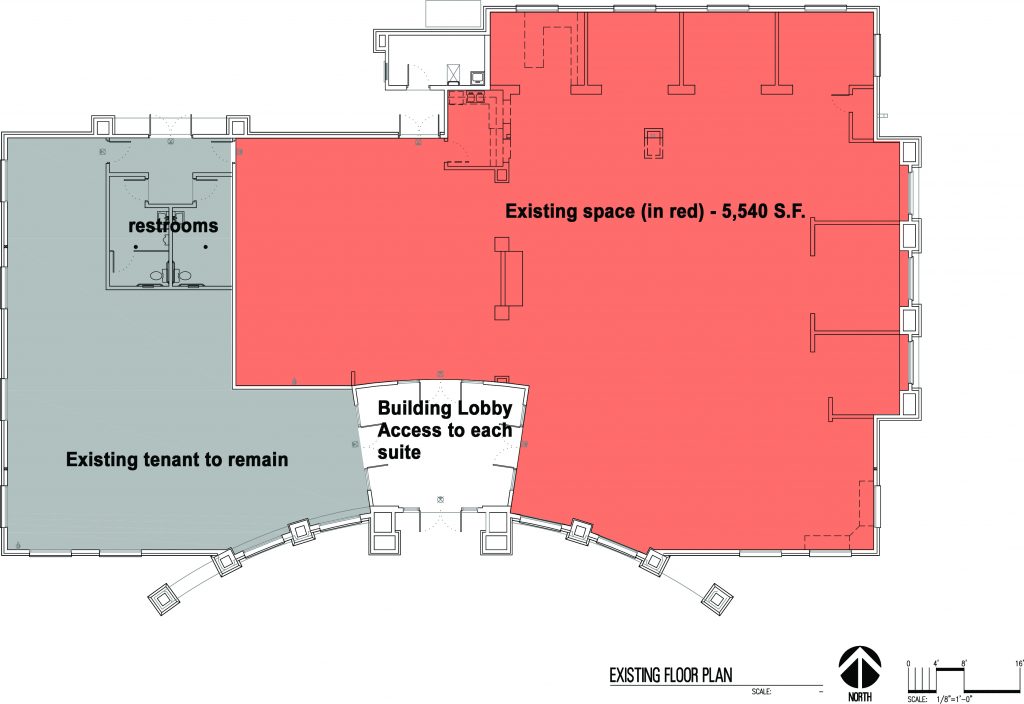
Office Architecture in Arizona – Existing building space available (shown in red)
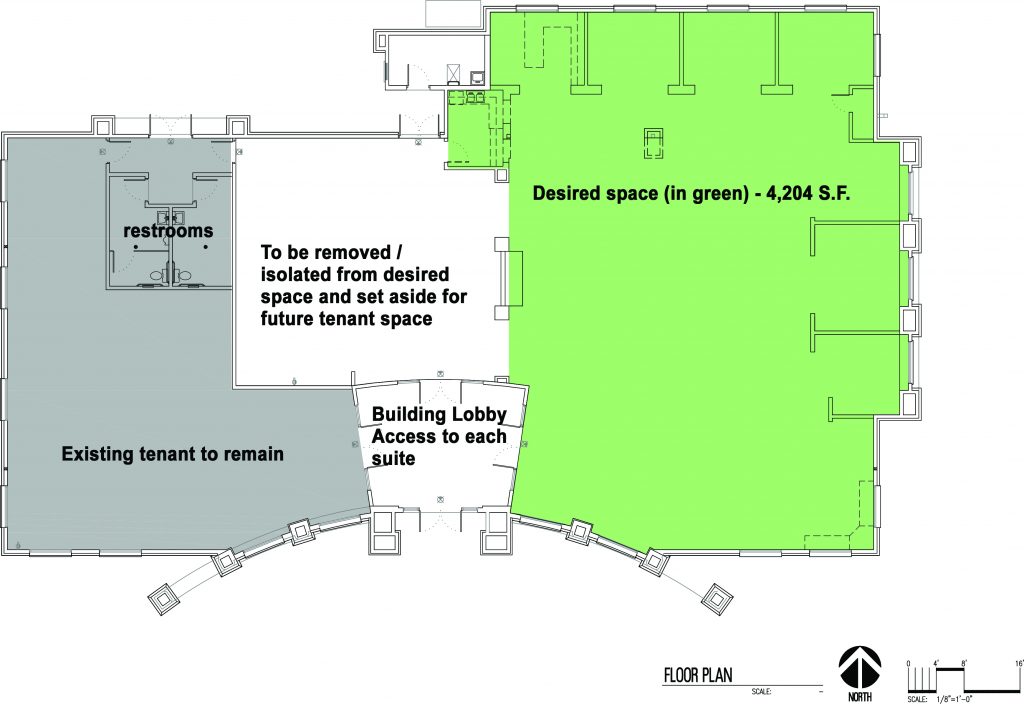
Office Architecture in Arizona – Proposed space (shown in green)
Analysis
The area in green is the desired quantity of space the tenant desired and which sensibly works with the division of the space due to existing walls allowing for a future tenant to be located within the center suite. This allows for each tenant, to remain unaffected, to have accessibility to entry lobby and existing restrooms.
Issues to Address
- Restrooms not accessible to proposed office space unless you travel through middle suite.
- Verify if restrooms (# of fixtures or toilets) meets current codes.
- Potential issue with exiting. # of exits and travel distance to exits will need to be analyzed.
- Determine if mechanical system zones (area the mech unit serve) is not affected by proposed leasable space.
- Determine if electrical systems are distributed properly for a division of the space into 2 separate suites.
- Verify number of parking spaces required/available affected by the proposed modification.
Analysis
It was determined that the existing building, constructed about 25 years ago, was initially designed as a product showroom, not offices. It was initially established as an Occupancy A (Assmebly) Proposed use of the new tenant was to be Occupancy B (Office). Based upon our code analysis, it was determined it had an affect on conflict 2 or quantity of toilets as explained below.
Conflict 1 – Restroom not accessible to space. A corridor was added to allow for access to the existing restrooms while adding a second exit from the space.
Conflict 2 – Verify restrooms meet code. Because Assembly occupancies do not require as many plumbing fixtures than Office space per occupant, the existing quantity of restrooms were adequate in the original use. With the change of occupancy to ‘B’ Office, the # of plumbing fixtures was not adequate. Therefore, one additional toilet stall was added to satisfy codes. (see calculations below). To minimize affecting the original restroom (not affecting its use by existing tenant and affecting existing finishes), it was decided that a 1 person restroom would satisfy the requirement of an additional toilet fixture. This was not a desired addition to scope because of the additional construction cost, but solely to satisfy the building code requirements.
Conflict 3 – Potential issue with existing? The office space as proposed met all exiting requirements. Quantity of occupants did not exceed the number to trigger additional exits. However, because of the accessibility to the restrooms, a second exit was provided.
Conflict 4 – Determine if mechanical system zones need modifications. Because of the original layout, the mechanical zones were not exactly divided into the zones that were established by the new wall creating the future tenant space. Therefore, ductwork modifications and a new mechanical unit was required to allow for the mechanical systems to function properly. This was an unknown addition to the project that the real estate agent would not be able to forsee.
Conflict 5 – Determine if electrical systems are distributed properly. It was determined, not to our surprise, that the electrical systems required separation of power to the 2 suites created. In reality, it could have remained more or less the same but by isolating the power, it allows for the building owner to clearly understand how much power each individual suite utilizes.
Conflict 6 – Is the number of parking spaces required/available affected? Fortunately because the occupant load from Assembly to Office reduced the number of occupants within the space, the number of existing parking spaces were more than adequate. No changes required.
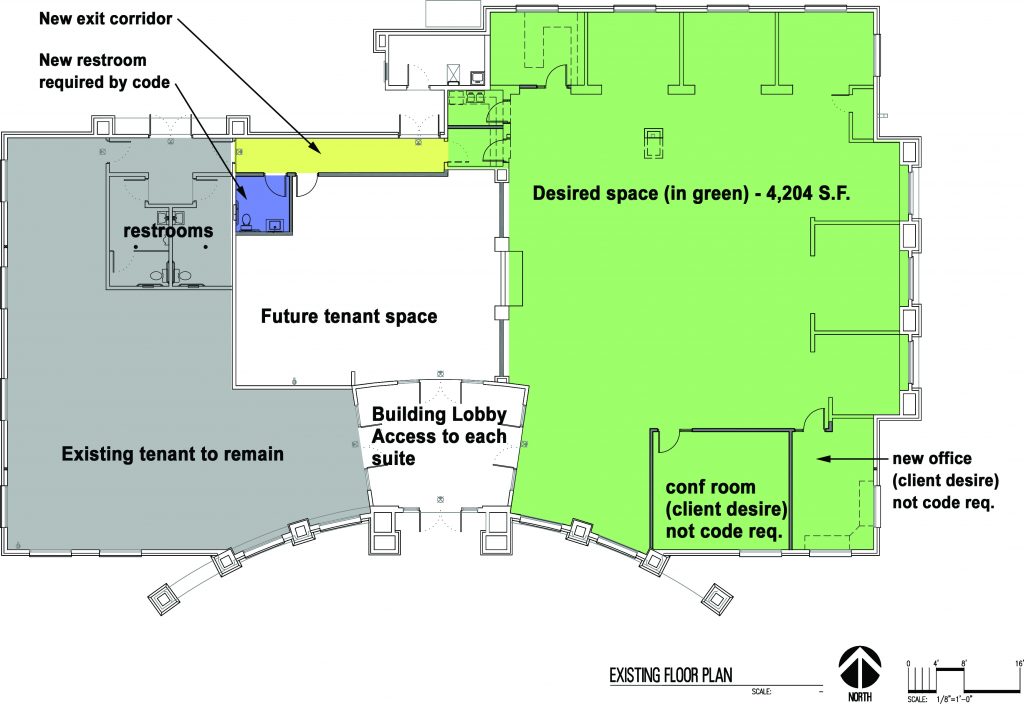
Office Layout
Additional code analysis information
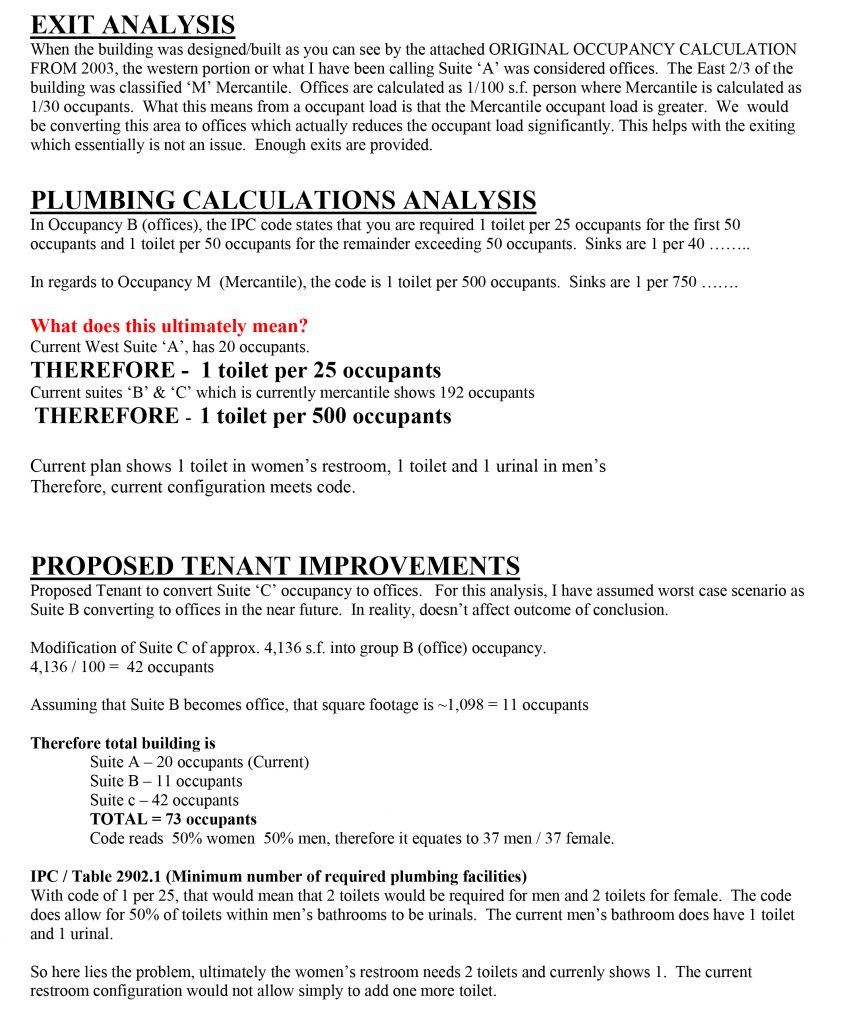
Summary
When finding an office space for rent, even in a simple remodel as shown in the case study, you can see how important research of issues are prior to signing a lease. The analysis will provide you with a more clear understanding of the possible scope due to modifications to the existing building systems, required updates due to current building codes and occupancy changes.
If you are considering an office architecture in the near future, hiring an architect can help you make good choices.

by Jeff Serbin | Jul 9, 2018 | architect in Arizona, Architectural Planning, Architecture, Blog, Collaboration, phoenix architects, Planning, Uncategorized
Looking for an Architect in Arizona?
Finding an architect in Arizona is similar to searching for a good auto mechanic, a veterinarian, a butcher, a banker, etc. Most of the time it is word of mouth if you have someone you can trust. When hiring most services, your relationship with the company or person is important. Architectural projects can last months or years depending on the scale or complexity of a project, therefore that relationship is important. Finding the right Architect in Arizona can be done with the following factors:
- Expertise
- Relationship
- Proximity
- Responsiveness
- Price
Expertise
Architects go through rigorous training in college, learning about history/theory of architecture, design/communication, technologies, practice/management, community design, preservation and all aspects of design. Therefore, an architect has an ability to obtain knowledge for any design challenge. Architects generally specialize in either residential or commercial. Even though some architects work in both arenas, most lean towards one. Many architects start in residential architecture getting their feet wet and later design commercial buildings only.
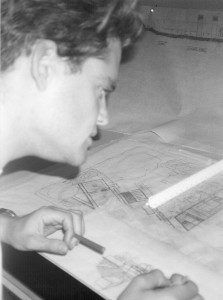
University life as an architect – Serbin
In the residential arena, architects may specialize in single family homes vs. multi-family or apartments. In commercial architecture, an architect may become an expert in a specific type of building such as: educational, office buildings, laboratories, warehouse, manufacturing, data center etc.
When finding an architect, ask them about their expertise to determine if their experience may fit your project type. However, as previous mentioned, an architects training teaches them to gather knowledge on any project, allowing them to truly handle most projects. Ask most architects, and they will confess they can design any type of building.
Architecture is truly a team approach. An architects role is to put together a team of designers and engineers qualified for the type of project. Therefore, even if the architect itself doesn’t have the type of building on their resume, the teams gathered experiences will allow for a successful project.
Relationship
Architecture can be a long process lasting months, even years. For some clients, it may be a one time project and the relationship short. Some clients have ongoing multiple projects which will foster a relationship that lasts for years. Nevertheless, the relationship between the architect and client is important. Getting along with the architect can somewhat be like a marriage. First is the courtship to determine if you have similar likes/dislikes (styles of architecture and expertise). Second, is the architect committed to the relationship to assist the client with their goals and aspirations (dedicated to making the building satisfy their needs). Third, once the honeymoon is over and the project is underway, can the relationship get through the challenges and struggles of the design and construction process. Can you communicate your likes and dislikes of the design and talk about money and project budget?

Relationship and Trust
Proximity
Architecture is a contextual art. Buildings are designed to relate to the environment. Architects must understand the general weather, solar aspects and orientation, site irregularities and natural disturbances from weather and even earthquakes. Since an architect, gathers knowledge on any project, proximity to the project is slightly less important. An Architect in Arizona must be registered within the State the project is located. However, hiring an architect for a desert climate like Arizona, one wouldn’t want to hire an architect who designs solely for the tropics.
When hiring local, someone from one side of town to the other, can have little effect upon a project. So finding an architect anywhere within your metropolitan area or even your state should be adequate. Most likely, the architect will travel to you to make the project easier.
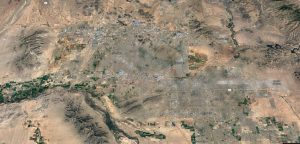
Proximity of Architect in Arizona
Responsiveness
Timely design is important to getting a project completed. First step is to hire a responsive architect, one who can educate that client on the process process to complete your project. The architect must determine the necessary steps to getting a permit and oversee the construction. Each site requires various approvals from local governing jurisdictions.
A time frame should be established for all the steps involved in the project. From zoning, design reviews, site plan reviews, building plan reviews to general construction durations, establishing a realistic time frame, with some wiggle room, is important. This will allow you to communicate to the architect your concerns if time feels like it’s slipping away.

Just like running track, you can’t wait around if you want to finish
Price
Design services can vary depending upon the complexity of the project. The architect is like the ringleader of a circus. They must gather up the necessary performers (ie. engineers) to allow for a successful show. Some projects may require specialists to ensure a proper design. A required, recommended and desired team of engineers could significantly affect the overall design fee.
List of potential engineers (as needed)
- Mechanical Engineer
- Plumbing Engineer
- Electrical engineer
- Structural Engineer
- Soils engineer
- Civil Engineer
- Security consultant
- Lighting consultant
- Acoustical consultant
- Landscape architect
- Utility Design consultant
Typical architectural fees for commercial projects vary, however ~8% of construction may be reasonable. However project types and overall construction costs factor into the percentage. Higher rates may occur due to complexity of the project. In general, the greater the construction cost, the lower the % fee. When an architect deals with a smaller project, the percentage is typically higher because of the basic tasks an architect must perform for any project. Typically I like to refer to “economies of scale”. If working on a renovation to an existing facility, hiring the original design team or even getting a hold of the original design documents can affect the overall design fees. Hiring an Architect in Arizona vs. outside the state will also save you time and money since the team doesn’t have to consider travel expenses and time within their fees.

Architects fee is worth every penny
Summary
Hiring the right architect is important for a successful project. One may hire an architect based upon seeing a completed building, word of mouth from a trusted colleague or a simple internet search. However factors such as expertise, relationship, Proximity, responsiveness and price factor into that selection. An architects expertise or ability to put together a team can create a successful project. Building the relationship with an architect can allow for trust. Proximity of the architect to the job site or more importantly, understanding the local area and governing jurisdiction is important for a well designed building. Responsiveness is important for a timely delivery. Architects design fee are important to allow for the project to fall within the project budget. Good luck!

by Jeff Serbin | Jun 19, 2018 | Architectural Planning, Architecture, Blog, Cloud Computing, colocation, Colocation Data Center, Data Center Design, Data Hall, Interiors, Planning, Uncategorized
Renovation of Data Center buildings
Since, 2004, or the past 15 years, Serbin Studio has been re-designing Data center buildings in Arizona. As computer storage and computing continues to grow due to new technologies, buildings are requiring more data storage. Since 2004, data hungry companies have been adding to the required storage on the web, such as Facebook (2004), Netflix (1997), Wikipedia (2001), Amazon Cloud Computing (2005), Apple / Iphone (2007), Black Friday web (2005), Youtube (2005) etc. During the life of these buildings within existing colocation (cloud) facilities, tenants move in and out of leases. This creates opportunities for data centers to refresh and update their systems to meet current demands and upgrade to new equipment for better efficiency. Prem Data Centers also need to be refreshed or expanded to meet current and future needs as companies grow or change.
Colocation Data Center or Cloud computing – “Multi-tenant environment that is contained within a building outside of a company’s facility. It can house all the companies data or be a backup facility for disaster recovery. The data hall environment can be maintained by the tenant (triple net lease) or all operation of the systems (ie. power distribution, mechanical cooling etc.) can be maintained by the Colocation Facility. Cloud computing allows a company to minimize infrastructure of onsite while having a backup to their data in a maintained secure environment”
On Prem Data Center – “Refers to private data centers that companies house in their own facilities and maintain themselves. Benefit to onsite is ultra controlled environment with minimal latency. It is measured in Mbps or Megabytes per seconds.“
Latency – Delay of transfer of a packet of data from one designated point to another. This can be affected by number of router hops. Since data centers can be physically located anywhere in the world, a customer may want to consider the geographic location of their data to minimize delays.
In Colocation facilities, when tenants move in/out, the new tenants needs are unique and the Data Halls are updated internally. Improvements to Data Center facilities don’t just stop at at the Data Hall. Common meeting spaces such as Lobby’s, customer lounges, conference rooms, common hallways, restrooms etc. need refresh as well. Exterior of buildings also require updates to be competitive with new facilities.
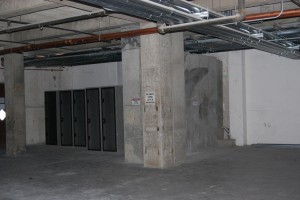
Raw space within Data Center building prior to remodel
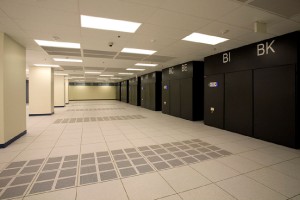
Data Hall remodel prior to Colocation tenants moving into space
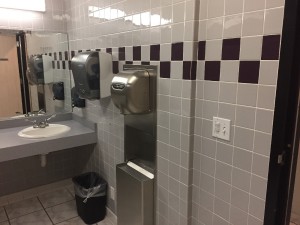
Data Center restroom prior to remodel. Circa 1980’s design
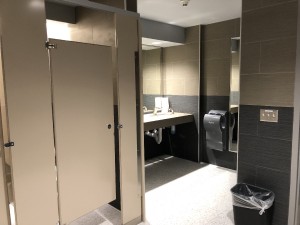
Restroom remodel in progress prior to completion. Terrazzo flooring, ceramic tile full height walls, solid surface counter with undermount sink etc.
Installation of new mechanical systems can upgrade the cooling capacity of the Data Hall. New power distribution systems and lighting systems can provide additional power and improve building efficiency.
Two types of Architects are required for a successful Data Hall environment.
Data Center Network Architect – “Design and support in the network planning, network architecture design, hardware and software, transmission and signaling links and protocols for a complete computer network. They evaluate new products and perform network problem resolution. Develop technical standards …… etc.”
and
Data Center Building Architect – “Design of building systems to support the Data Hall environment including a safe and secure invironment with adequate power and cooling required within the space to support server equipment. Buildings are designed to structurally support the equipment as electrical equipment can be quite heavy. Architects specialize in the design of support spaces (ie. lobby, offices, conference rooms, restrooms, customer lounge etc.) to provide a comfortable working environment.”
Serbin Studio specilizes in Data Center Building Architecture. We have put together a highly experience team of architect, Mechanical, plumbing , Electrical Engineer and structural engineers and other necessary design support to ensure quality, efficient and timely designs. Projects can be design-bid-build and design-build. The design team can handle all aspects of renovations to existing Data Center facilities and New builds. From small power upgrades to a rack, building cooling upgrades, Common space remodels, to conceptual space planning, our team is ready to handle any task. Since 2004, we have facilitated over 300+ projects ranging from several thousand dollar upgrades to multi million dollar upgrades to existing facilities.


























